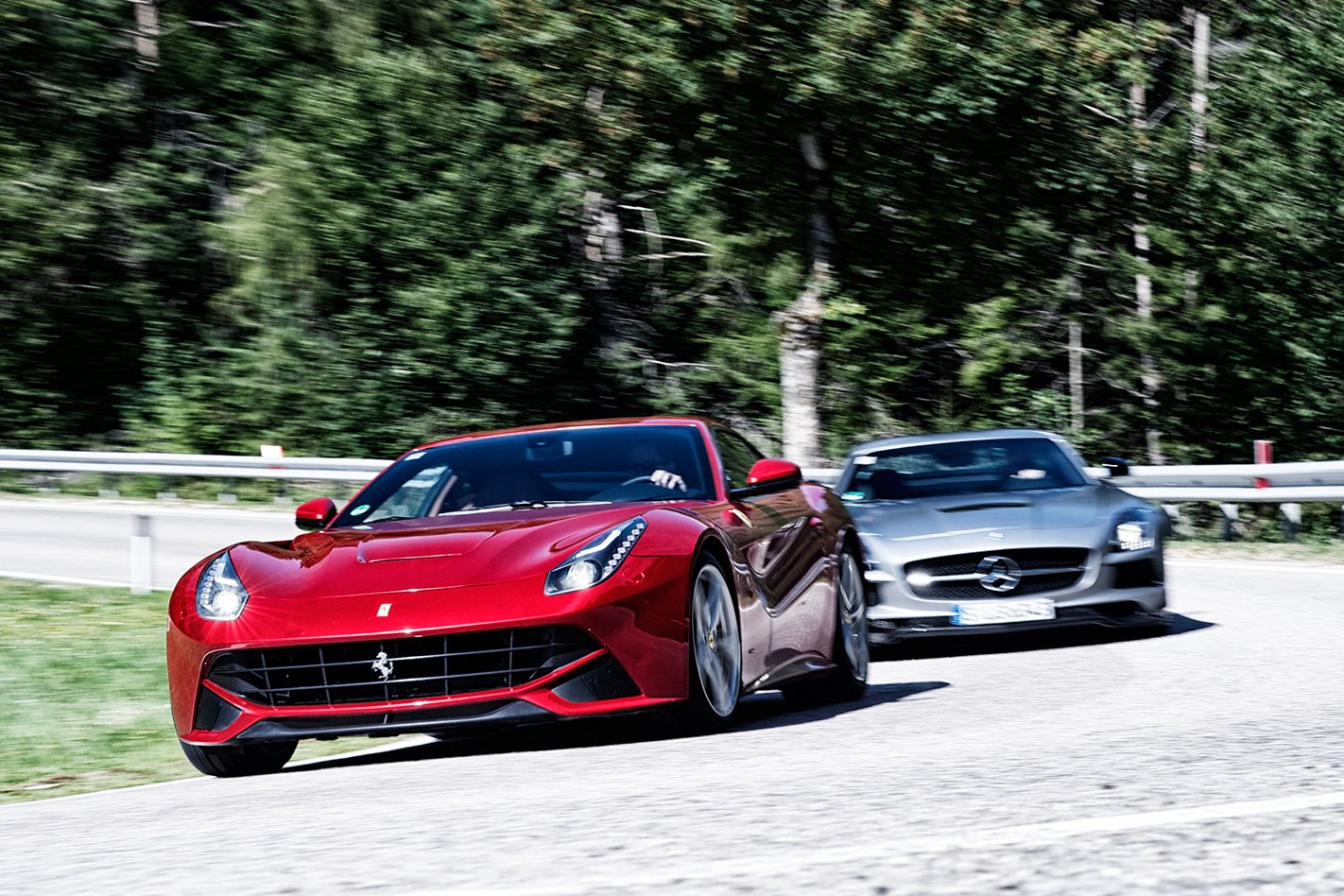A long weekend in the F12 and the SLS Black? Now, that’s an adrenaline-pumping fantasy. And we’re about to make it a reality.
This article was originally published in the November 2013 issue of MOTOR.
The high-end products from Maranello and Affalterbach share a remarkably similar DNA: potent front-mid-mounted engine, slick seven-speed dual-clutch transaxle transmission, riveting carbon-ceramic brakes, striking aluminium-intensive two-seater coupe bodies.
Although Ferrari is in this league again, fielding a mighty V12 that develops nearly 100kW more than the German V8, the SLS SMG is 25 kilos lighter and aerodynamically even more efficient. Against the stopwatch, the F12 Berlinetta has a slight edge, but performance is not the decider in this shootout. What matters more are style and character, accessibility and response, adaptability and balance.
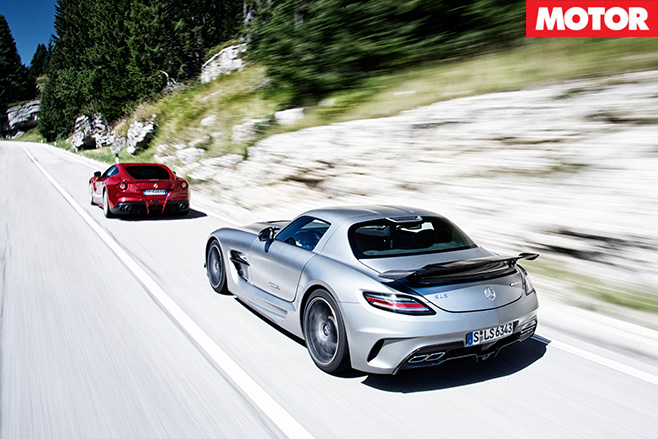
We could have tested these sophisticated sledgehammers on the Salzburgring or in Varano. However, a late summer loop across the alps from Bavaria through Tyrol to Northern Italy seemed like a more exciting, multi-faceted proposition. After all, the chosen route would include Vmax blasts on the autobahn, a handful of breathtaking passes guaranteed to change the passenger’s complexion from rosy to ivory, enough second-gear corners to kick up Michelin stock a fraction, and plenty of quiet, mercifully radar-free backroads.
However, what slowed our 1009kW convoy at times was the inevitable holiday traffic – and far too many fuel stops. After only 320km, the Ferrari’s red warning LEDs cried out for a refill for the first time. And the Mercedes was almost equally thirsty. At the pumps, 26L/100km (SLS) to 30L/100km (F12) were the rule, not the exception to it. Where the ubiquitous 130km/h speed limit was strictly enforced, the numbers improved to 14 and 16L/100km respectively.
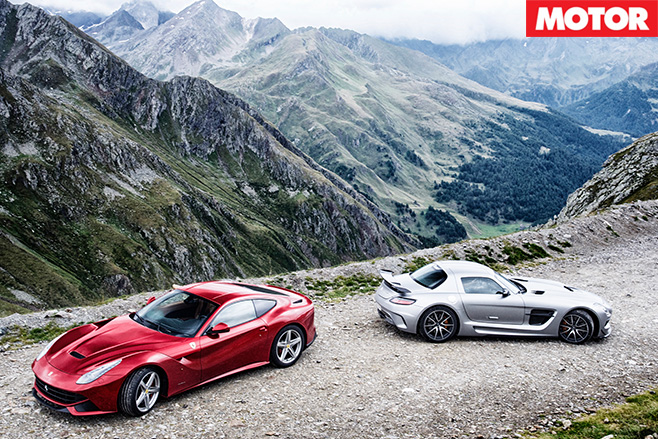
The SLS Black Series that went on sale in Europe in June was inspired by the race-winning GT3, and it shows, especially when you opt for the pricey aero kit fitted to the test car. Eye-catching add-ons include tailor-made wheels, carbon-fibre flics to support the deep front spoiler, four chromed tailpipes embedded in a chiselled diffusor, and a tall fixed rear wing which absolutely hates automatic carwashes.
Although the presentation is about as subtle as a Lady Gaga video, it does the job by significantly enhancing grip and downforce. Like the new CLA-class, the SLS relishes the wow effect it has on bystanders and other drivers.
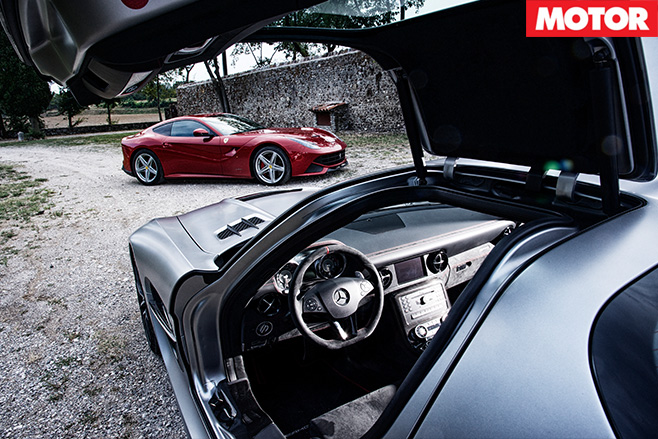
Unlike the Challenge Stradale, Scuderia and Speciale, the F12 Berlinetta does without provocative livery. The first Ferrari designed in-house by Flavio Manzoni rather than Pininfarina looks butch enough for a supercar, but at the same time it is strikingly chic and even more space-efficient than the larger 599 GTB it replaces. In contrast to the extrovert SLS and its martial wing-work, the F12 conceals its aerodynamic efficiency well.
Thanks to a complex and clever airflow concept that incorporates various subtle ducts and scoops, the spoilerless F12 actually generates twice as much downforce at 200km/h as its predecessor. When you drive it at the limit of adhesion from mountaintop to valley floor, two flaps in the front air dam open to cool down the brakes.
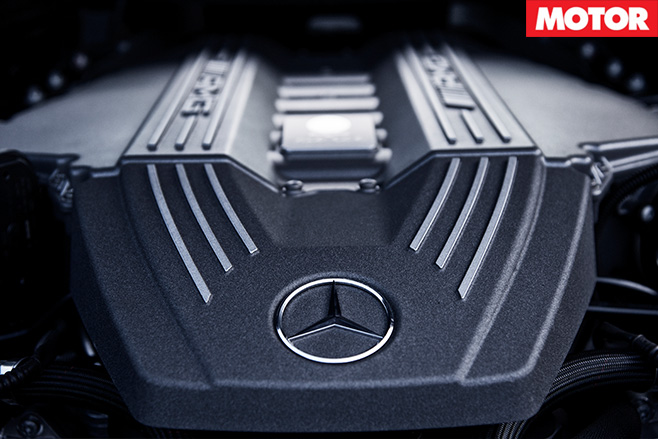
Maximum speed may not be a priority in North America, but it’s highly relevant in the old world, where plain-clothes repmobiles typically cruise at 200km/h. The 464kW Black Series can do 317km/h, which is actually 1.6km/h slower than the 420kW base model and the 435kW GT.
How come? Because this version is geared for more low-end grunt and even stronger mid-range acceleration. Thanks to a revised valvetrain, hotter camshafts, free-flow intake system and larger-diameter exhaust, the higher-revving 6208cc unit gains 30kW in power while the maximum torque is actually down from 650 to 635Nm.
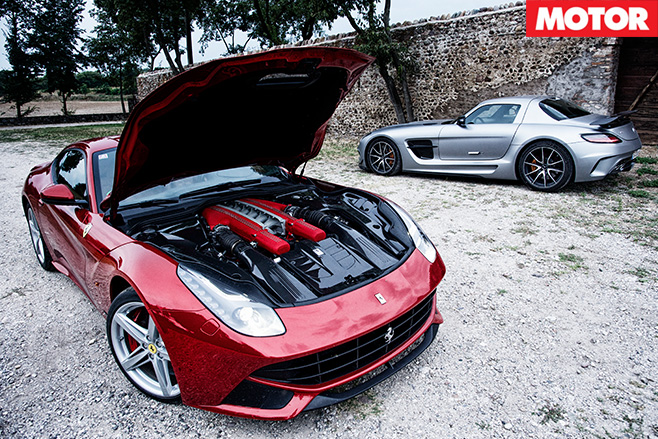
Due to traffic and weather, we never saw more than 290km/h in either vehicle, which is why the flat-to-the-horizon duel between red and silver was a dead heat most of the time. At any speed, the AMG car is noisier, more nervous and less well tied down on imperfect bitumen.
Although both vehicles use the same Getrag gearbox, different applications apply. In the Benz, you can choose from four shift programs labelled Comfort, Sport, Sport Plus and Manual. In the Ferrari, you have five manettino settings – Wet, Sport, Race, ASR off and ESP off – plus an auto mode.
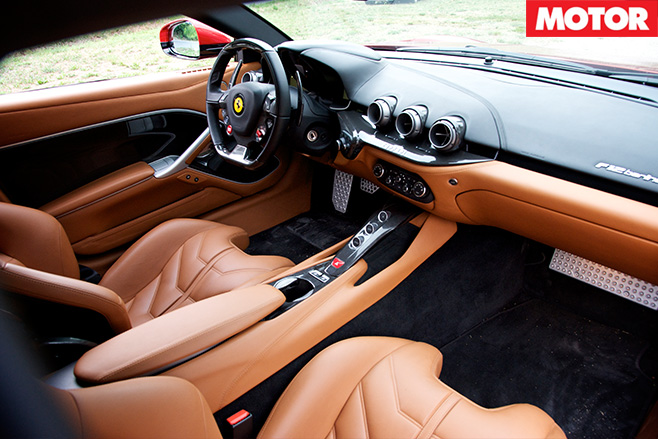
Those who prefer to let the car select the appropriate cogs might as well forget the Ferrari and zoom in on the SLS, period. In Sport-plus, the mighty Merc is eerily good. Sure, this gearchanging wizardry is 100 percent electronic, but the angry blat-blat that mimics heel-and-toeing, the perfectly timed lift-off misfire and the clutch-slip-induced kick in the butt that accompanies pedal-to-the-metal upshifts makes it a soundtrack worthy of the next Fast and the Furious.
After weaving our way through the metal maze on the A8 from Munich to Innsbruck, and meandering through a marathon cycling contest all the way to the end of an idyllic green snake better known as the Ötz Valley, the time has finally come to let the two crackerjacks off the leash.
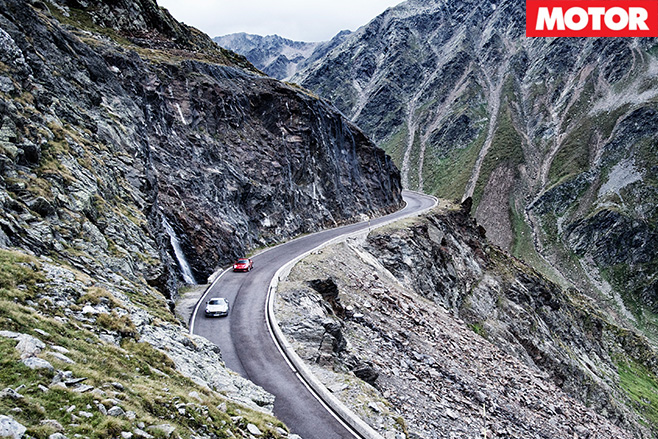
The Ferrari is better prepared for these treacherous conditions. Its Pilot Sport SUP road tyres hang on longer, snap-oversteer is less pronounced, and even with traction control switched off enough of that underlying confidence-inspiring creaminess shines through. The quicker steering, more compliant suspension and wider 20in rubber all help. Both cars have chip-controlled limited-slip diffs which distribute the torque efficiently between the rear wheels. And there is torque aplenty: the V8 has 635Nm at 5500rpm, the V12 690Nm at 6000rpm.
During off-season, we would have criss-crossed south through the Dolomites where legendary passes like Stelvio, Pordoi, Rolle and Falzarego beckon. But right in the middle of Ferragosto, when the whole of Italy is taking at least three weeks off, it was wiser to divert to more remote twisties like the Altopiano Dei Sette Communi and the Catena Dei Lagorai.
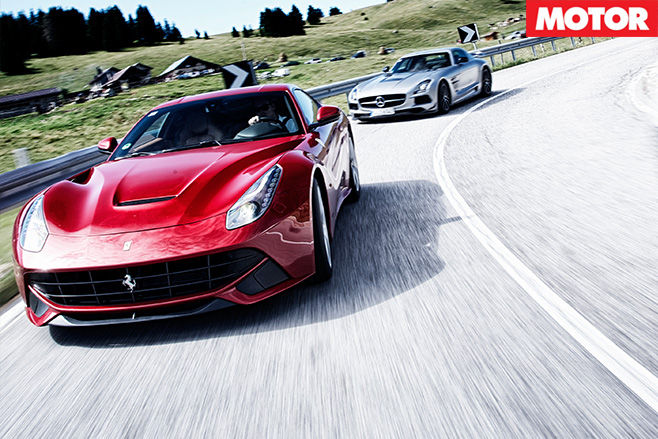
The Ferrari feels more at home in this beautiful but constrained habitat. Its steering is half a lock quicker, its turning circle is marginally tighter, its eye-catching body sits on a less squirmish wheelbase which eclipses the SLS by 40mm. Redlined at 8700rpm, the V12 does not only produce more top-end go than the V8, which expires at 8000rpm, it also serves a slightly larger portion of low- to mid-range grunt.
To qualify for the tiny Black Series badge, the chassis of the big bad Benz received a more muscular set-up with two-stage damping, firmer elastokinematics for better yaw suppression, a fatter anti-roll bar in the front for further reduced bodyroll, lightweight wheels, less power assistance for the otherwise unchanged steering, a wider track and bespoke tyres. This recipe works wonders on a circuit, but is to a certain extent counterproductive in the real world dotted with crests, dips, potholes, cattle grids and railway crossings.
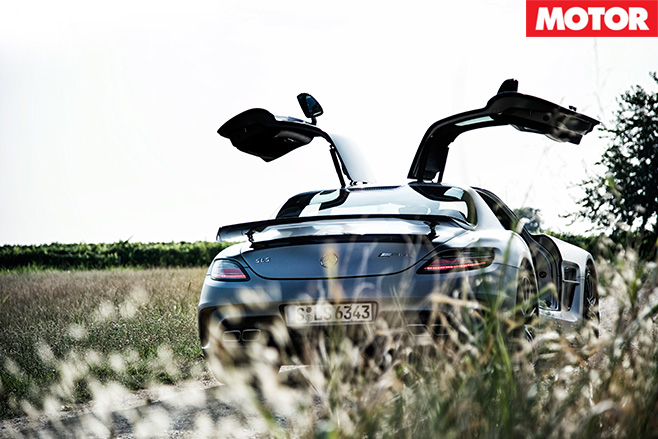
Where the SLS Black goes through teeth-grinding crash-bang-wallop motions, the Ferrari permits quantifiably more wheel travel, more generous shock absorber compression and rebound, and more body movement along both axes. The effect is a level of transparency and control the silver warrior on German plates cannot match.
Germany is autobahn paradise, Austria picture-postcard homeland, and Italy all that plus fast-car-friendliness. When you get stopped by a policewoman for trespassing in triple-digit speed territory on a rural throughway and the first question the lady asks is “Which car wins?”, you know for certain that you’re in Italy.
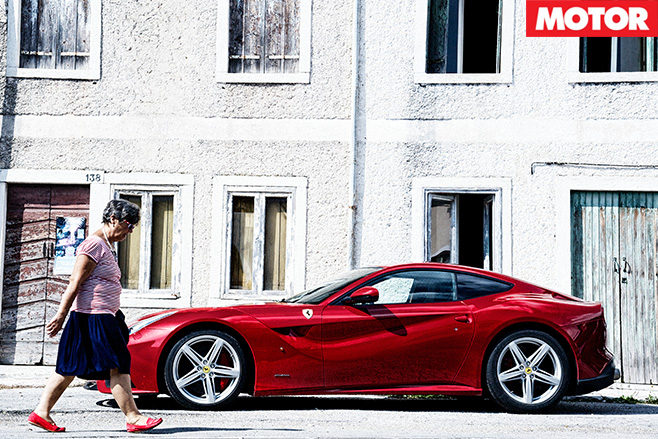
While the F12 soundtrack is composed primarily by flaps, valves, blades and actuators, the AMG engine is more of an exercise in acoustic technotronics. In both cars, ample perforation ensures that driver and passenger hear loud and clear what makes passersby cheer.
Where the great alpine amphitheatre opens up and the wide plains begin to spread their colourful blanket, the crisp and cool alpine air fuses with a misty warmth that pushes northwards from the Adriatic Sea. In the heart of the Veneto Province, we aim South and head for Vicenza, now travelling on much smoother, faster roads.
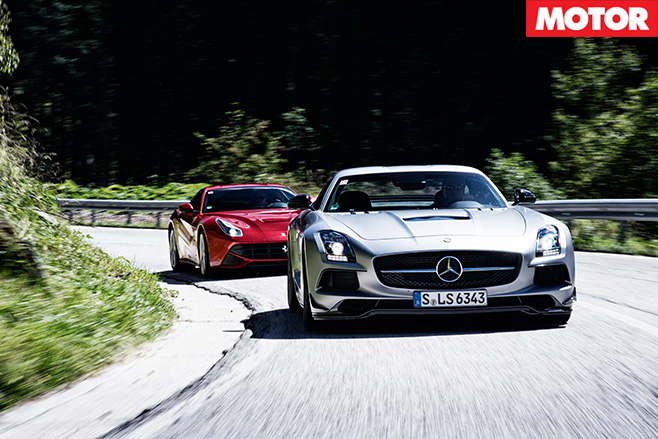
But every time their young eyes check the rear-view mirror, my face still looms large at the wheel of the SLS. There is no doubt about it: on the road, rather than the track, the broad-shouldered SLS AMG Black Series can keep up with every step the F12 takes. And while the Ferrari won’t shine unless whipped through its ratios, all it takes for the Benz on steroids to play grandmaster grunt is a firm stab at the throttle.
Miraculously, the autostrada from Piovene to Vicenza is as deserted as a supermarket carpark at midnight. But this short 32km feeder stretch to the busy A4 turns out to be a rough bit of blacktop with yawning expansion joints, ankle-deep aquaplaning grooves and a glistening surface polished by many summer suns.
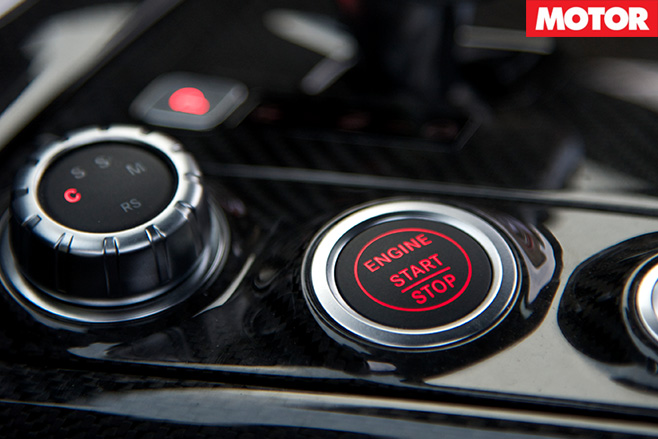
What this multilink kickback layout quite obviously lacks is a larger measure of compliance and a rear axle that works in sync with you rather than against you. On the racetrack, this uncompromising attitude rarely fails to satisfy. On 24/7 bitumen, it generates rather too much excitement for body and mind.
The F12 irons out these physical idiosyncrasies with aplomb. Unlike the SLS, which feels portly by comparison and has relatively heavy steering and muscle-building brakes, the Ferrari can be perceived as a wiry lightfoot with quick reflexes and sharp handling defined by consummate ease … up to a point. You see, even after three days, we felt the F12 steering was a bit light, especially when you wind on more lock, and the brakes are hyper-sensitive.

In Italy, where a litre of five-star fuel can cost A$3, or as much as a bottle of perfectly quaffable red, filling up these two behemoths seriously dents most travel budgets. But those who can afford an F12 or an SLS Black will probably not bat an eyelash, having forked out almost A$700K and around A$640K respectively for their evocative playthings (sans extras).
If you plan to use your car as a daily driver and aren’t interested in racing it, save yourself some money and buy the regular AMG SLS. But if you’re looking for a seriously fast and competent track-day special, and you want the enhanced street cred the go-faster package might provide, this special SLS will generate more smiles per slides, guaranteed.
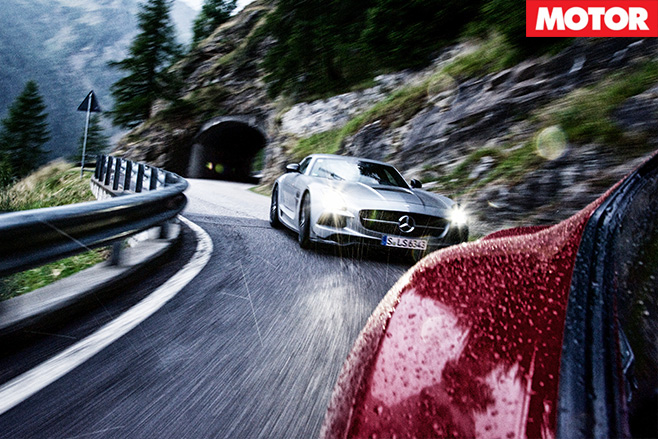
Why? Well, the Ferrari looks and feels more special, it goes faster and rides better, it is softer-edged and yet every bit as hardcore as the SLS Black in terms of handling, roadholding and performance. Downsides? The infotainment is not quite up to date, the transmission needs more sparkle in auto mode, ‘tip out’ triggers excessive engine braking, while a smooth take-off and a fluid crawling pace are not this car’s forte. Exactly the same applies to the SLS, so Getrag had better get its DCT in order, fast.
Having said all that, the gullwing fields a more compelling gearbox software, it is every bit as entertaining at the limit, the sat-nav deserves full marks, while the steering, brakes, chassis and drivetrain form a cohesive whole. But the Black Series is harshly sprung and damped, it is a little too eager to put up a fight when pushed, and its shirt-sleeved composure is provocatively in line with its jazzy demeanour.



